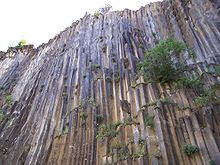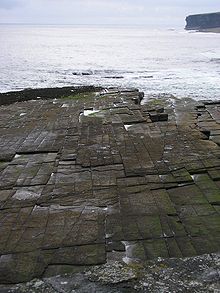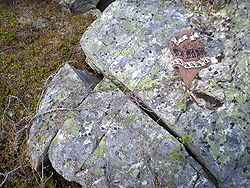- Joint (geology)
-
 Columnar jointed basalt in Turkey
Columnar jointed basalt in Turkey
In geology the term joint refers to a fracture in rock where the displacement associated with the opening of the fracture is greater than the displacement due to lateral movement in the plane of the fracture (up, down or sideways) of one side relative to the other. Typically, there is little to no lateral movement across joints. This makes joints different from a fault which is defined as a fracture in rock in which one side slides laterally past the other with a displacement that is greater than the separation between the blocks on either side of the fracture. Joints normally have a regular spacing related to either the mechanical properties of the individual rock or the thickness of the layer involved. Joints generally occur as sets, with each set consisting of joints sub-parallel to each other.
Contents
Formation
Joints form in solid, hard rock that is stretched such that its brittle strength is exceeded (the point at which it breaks). When this happens the rock fractures in a plane parallel to the maximum principal stress and perpendicular to the minimum principal stress (the direction in which the rock is being stretched). This leads to the development of a single sub-parallel joint set. Continued deformation may lead to development of one or more additional joint sets. The presence of the first set strongly affects the stress orientation in the rock layer, often causing subsequent sets to form at a high angle to the first set.
Joint sets are commonly observed to have relatively constant spacing, which is roughly proportional to the thickness of the layer.[1]
Types of joints
Joints are classified by the processes responsible for their formation, or their geometry.
Types with respect to formation
Tectonic joints
Tectonic joints are formed during deformation episodes whenever the differential stress is high enough to induce tensile failure of the rock, irrespective of the tectonic regime. They will often form at the same time as faults. Measurement of tectonic joint patterns can be useful in analyzing the tectonic history of an area because they give information on stress orientations at the time of formation.[2]
Unloading joints (Release joints)
Joints are most commonly formed when uplift and erosion removes the overlying rocks thereby reducing the compressive load and allowing the rock to expand laterally. Joints related to uplift and erosional unloading have orientations reflecting the principal stresses during the uplift. Care needs to be taken when attempting to understand past tectonic stresses to discriminate, if possible, between tectonic and unloading joints.
Exfoliation joints are special cases of unloading joints formed at, and parallel to, the current land surface in rocks of high compressive strength.
Cooling joints
Joints can also form via cooling of hot rock masses, particularly lava, forming cooling joints, most commonly expressed as vertical columnar jointing. The joint systems associated with cooling typically are polygonal because the cooling introducing stresses that are isotropic in the plane of the layer.
Types with respect to attitude and geometry
Joints can be classified into three groups depending on their geometrical relationship with the country rock:
-
- Strike joints – Joints which run parallel to the direction of strike of country rocks are called "strike joints"
- Dip joints – Joints which run parallel to the direction of dip of country rocks are called "dip joints"
- Oblique joints – Joints which run oblique to the dip and strike directions of the country rocks are called "oblique joints".
Fractography
Joint propagation can be studied using the techniques of fractography in which characteristic marks such as hackles and plumose structures can be used to determine propagation directions and, in some cases, the principal stress orientations.[3]
Importance to soil and rock mass strength
In geotechnical engineering a joint forms a discontinuity that may have a large influence on the mechanical behavior (strength, deformation, etc.) of soil and rock masses in, for example, tunnel, foundation, or slope construction.
Importance in the production of geofluids
It is long been recognized that joints (fractures) play a major role in the subsurface fluid flow of water in aquifers and petroleum in oil fields. Major industry research projects have been dedicated during the last decades to the study of faulted and fractured reservoirs.[4][5]
See also
References
- ^ Ladeira,F.L. & Price,N.J. 1981. Relationship between fracture spacing and bed thickness. Journal of Structural Geology, 3, 179-183
- ^ Engelder, T. & Geiser, P. 1980. On the use of regional joint sets as trajectories of paleostress fields during development of the Appalachian Plateau, New York. Journal of Geophysical Research, 85, B11, 6319-6341.
- ^ Roberts, J.C. 1995. Fracture surface markings in Liassic limestone at Lavernock Point, South Wales. Geological Society, London, Special Publications; v. 92; p. 175-186
- ^ Guerriero V. et al. (2011). "Improved statistical multi-scale analysis of fractures in carbonate reservoir analogues" (PDF). Tectonophysics (Elsevier) 504: 14–24. http://dx.doi.org/doi:10.1016/j.tecto.2011.01.003.
- ^ Guerriero V. et al. (2010). "Quantifying uncertainties in multi-scale studies of fractured reservoir analogues: Implemented statistical analysis of scan line data from carbonate rocks" (PDF). Journal of Structural Geology (Elsevier) 32 (9): 1271–1278. http://dx.doi.org/doi:10.1016/j.jsg.2009.04.016.
Categories:- Structural geology
- Geology terminology
-
Wikimedia Foundation. 2010.




